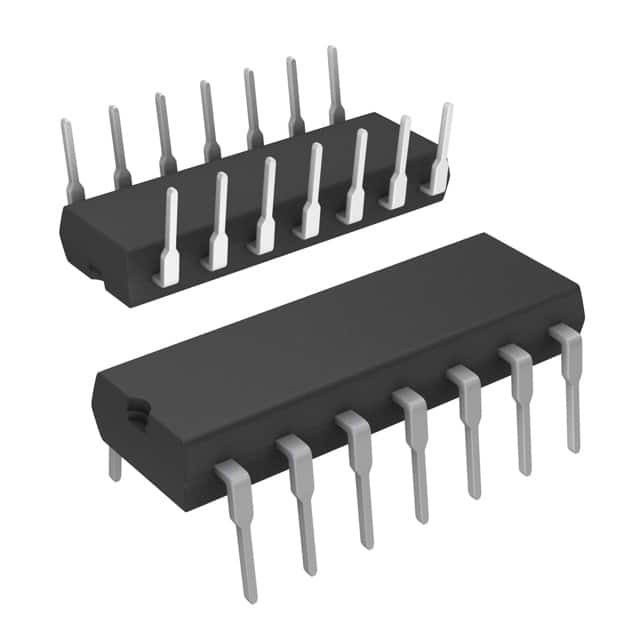DM74AS286N
Product Overview
- Category: Integrated Circuit (IC)
- Use: Logic Function
- Characteristics: High-Speed, 9-Bit Parity Generator/Checker
- Package: DIP (Dual In-line Package)
- Essence: The DM74AS286N is a high-speed integrated circuit that performs the function of a 9-bit parity generator/checker. It is commonly used in digital systems to ensure data integrity by generating or checking parity bits.
- Packaging/Quantity: The DM74AS286N is typically packaged in a DIP package and is available in various quantities.
Specifications
The DM74AS286N has the following specifications:
- Supply Voltage: 4.75V to 5.25V
- Operating Temperature Range: -55°C to +125°C
- Input Voltage: 0V to VCC
- Output Voltage: 0V to VCC
- Propagation Delay: 12ns (max)
- Power Dissipation: 500mW (max)
Detailed Pin Configuration
The DM74AS286N has a total of 14 pins, each serving a specific purpose. The pin configuration is as follows:
- GND (Ground)
- A0 (Data Input Bit 0)
- A1 (Data Input Bit 1)
- A2 (Data Input Bit 2)
- A3 (Data Input Bit 3)
- A4 (Data Input Bit 4)
- A5 (Data Input Bit 5)
- A6 (Data Input Bit 6)
- A7 (Data Input Bit 7)
- A8 (Data Input Bit 8)
- P (Parity Output)
- C (Carry Output)
- G2 (Enable Input)
- VCC (Supply Voltage)
Functional Features
The DM74AS286N offers the following functional features:
- Parity Generation: The IC can generate a parity bit based on the input data bits.
- Parity Checking: It can check the parity of the input data bits and provide an output indicating whether the parity is correct or not.
- Carry Output: The carry output indicates whether an overflow occurred during the parity generation/checking process.
- High-Speed Operation: The IC operates at high speeds, making it suitable for time-critical applications.
Advantages and Disadvantages
Advantages of using the DM74AS286N include:
- High-speed operation
- Compact DIP package
- Reliable parity generation/checking
Disadvantages of the DM74AS286N include:
- Limited to 9-bit parity generation/checking
- Requires external enable signal for operation
Working Principles
The DM74AS286N works by taking the input data bits and performing a parity calculation. It generates a parity bit based on the input data bits and provides an output indicating whether the parity is correct or not. The carry output indicates whether an overflow occurred during the parity generation/checking process.
Detailed Application Field Plans
The DM74AS286N finds applications in various digital systems where data integrity is crucial. Some of the detailed application field plans include:
- Data Communication Systems: Used to ensure error-free transmission of data over communication channels.
- Memory Systems: Employed to detect and correct errors in stored data.
- Computer Networks: Utilized to maintain data integrity during transmission across network nodes.
- Error Detection and Correction Systems: Integrated into systems that require reliable data processing.
Detailed and Complete Alternative Models
There are several alternative models available that offer similar functionality to the DM74AS286N. Some of the popular alternatives include:
- SN74LS280: 9-Bit Parity Generator/Checker with similar specifications.
- CD4016BE: Quad Bilateral Switch with different functionality but compatible package and pin configuration.
- MC14081B: Quad 2-Input AND Gate with different functionality but compatible package and pin configuration.
These alternative models can be considered based on specific requirements and compatibility with the existing system.
Word count: 470 words
רשום 10 שאלות ותשובות נפוצות הקשורות ליישום של DM74AS286N בפתרונות טכניים
Sure! Here are 10 common questions and answers related to the application of DM74AS286N in technical solutions:
Q: What is DM74AS286N? A: DM74AS286N is a specific type of integrated circuit (IC) commonly used in digital electronics for various applications.
Q: What is the function of DM74AS286N? A: DM74AS286N is a 9-bit binary-to-binary coded decimal (BCD) converter. It converts a 9-bit binary input into a BCD output.
Q: How many inputs does DM74AS286N have? A: DM74AS286N has 9 input pins, each representing a bit of the binary input.
Q: How many outputs does DM74AS286N have? A: DM74AS286N has 4 output pins, representing the BCD output.
Q: What is the voltage range supported by DM74AS286N? A: DM74AS286N typically operates with a voltage range of 4.75V to 5.25V.
Q: Can DM74AS286N be used in both digital and analog circuits? A: No, DM74AS286N is specifically designed for digital circuits and should not be used in analog applications.
Q: What is the maximum clock frequency supported by DM74AS286N? A: The maximum clock frequency supported by DM74AS286N is typically around 30 MHz.
Q: Can DM74AS286N be cascaded to handle larger binary inputs? A: Yes, multiple DM74AS286N ICs can be cascaded together to handle larger binary inputs.
Q: Are there any special considerations for power supply and decoupling capacitors? A: It is recommended to provide a stable power supply and use decoupling capacitors near the IC to minimize noise and ensure proper operation.
Q: What are some common applications of DM74AS286N? A: DM74AS286N can be used in various applications such as digital counters, calculators, digital displays, and other systems requiring binary-to-BCD conversion.
Please note that these answers are general and may vary depending on specific datasheets and application requirements.


